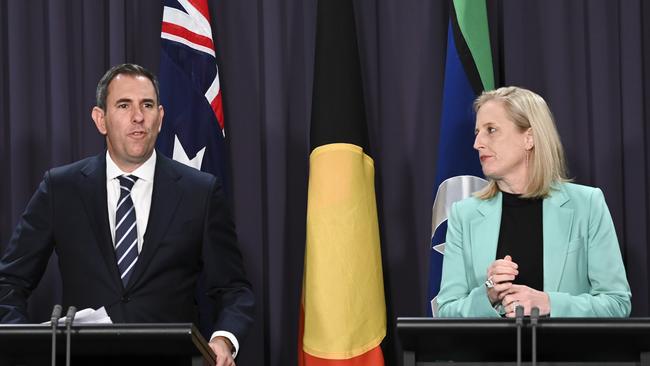
The final budget outcome on Monday confirmed the government’s lower spending claim was undermined by billions of dollars in deferred payments to states and lower demand rather than any meaningful savings drive.
Confronting deteriorating economic conditions and with Treasury predicting a $28.3bn deficit in the current financial year and decades of budgets in the red, Anthony Albanese has limited appetite for a pre-election budget. An election eve deficit combined with prolonged cost-of-living pressures would spur Coalition claims that Labor can’t manage the economy.
As revealed last month by The Australian, senior Labor government figures are working towards a March election option with no concrete plans for a pre-election budget.
Falling commodity prices, lower tax takes, higher welfare payments, eye-watering structural spending, a weakening jobs market and migration cuts will heap pain on a budget propped up by a stronger than expected post-Covid boom that is now busted.
Labor attacks on the Coalition for leaving Australia with “$1 trillion of debt” are now redundant after net debt hit $491.5bn in 2023-24. Doomsday Treasury projections in Josh Frydenberg’s October 2020 pandemic budget that net debt would reach $966.2bn by 2023-24 overshot the mark by a whopping $474.7bn.
Frydenberg, whose dream of bringing the budget “back to black” was cruelled by the pandemic, can take some credit for Chalmers’ two surpluses built on a fast-rebounding economy and bumper revenue upgrades fuelled by record commodity prices and a surging tax take.
Coalition figures note Swan, who inherited virtually no net debt from Peter Costello, left behind net debt measuring about 11.1 per cent as a share of GDP. While Chalmers’ mentor and former boss did manage the GFC response, Coalition sources quipped you could argue more than half of net debt as a share of the economy was accumulated under Labor. The government’s 2023-24 net debt bill of $491.5bn is running at 18.4 per cent of GDP.
Amid plunging support in opinion polls and expectations of a hung parliament, the government fears running full-term could give the Coalition an upper hand.
A March election is also linked to Labor hopes the RBA board will cut rates at its February meeting. While economists predict it will lower the 4.35 per cent cash at its first meeting in 2025, there is no guarantee the central bank will grant Albanese’s wish.
Chalmers and Katy Gallagher are now tasked with preparing a Mid-Year Economic and Fiscal Outlook provides Albanese with spending ammunition ahead of a potential March election.
In addition to new cost-of-living sweeteners, expect Chalmers to bankroll a raft of Labor election policies in the secretive MYEFO line item dubbed “decisions taken but not yet announced and not for publication”.




Jim Chalmers has borrowed Wayne Swan’s box of magic fiscal tricks to deliver a “smoke and mirrors” surplus that firms up expectations of a March election.